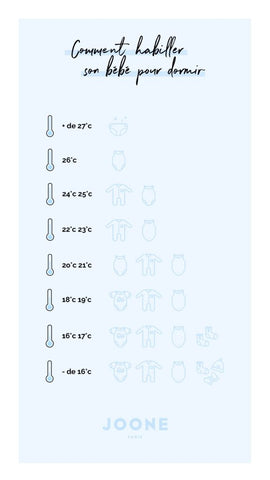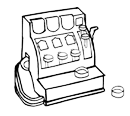5 tips to relieve baby during a heatwave
It's hot, much too hot! We want to do nothing but lie naked starfish-style on the tiled floor in front of a fan. And let's not even mention the sleepless nights flooding the mattress with our perspiration. What bliss! These temperatures are unbearable, but we'd better get used to them ... #helloglobalwarming. If the weather makes your days and nights uncomfortable, imagine how it feels for an infant who, in the first few months of life, has an immature system for regulating body temperature. To help you get through those hot days as well as possible, here are 5 valuable tips.
Babies are particularly sensitive to heat. In addition to discomfort, the main risk in heatwaves is dehydration caused by hyperthermia, which in some cases can rapidly become a life-threatening emergency. Unable to sweat in order to regulate their body temperature, children become overheated, causing the temperature inside their bodies to rise dangerously which can impair the functioning of their vital organs. Without turning into a psychosis, it's vital to pay close attention to your child's general state of health in hot weather, and to ensure that he or she is regularly cooled and sufficiently hydrated.
Signs of dehydration
Contact a pediatrician or emergency room if the baby wets fewer than six diapers in 24 hours, or if his urine is particularly concentrated (dark yellow) and smelly. Another warning sign is a change in the baby's behavior: s'he's apathetic and "limp" or s'he's losing weight rapidly, has a gray complexion, dark circles under his eyes, s'he has a fever or a sunken fontanel.
1. Appropriate clothing
Generally speaking, it's a question of common sense. As with you, opt for loose-fitting outfits in lightweight materials that let air pass through the fabric. Preferably opt for light colors, and if possible, don't hesitate to let baby run around in a diaper, but always sheltered from the sun. The only essential accessories for outings: a hat to protect the head, forehead and nape of the neck, sunglasses adapted to the fragile eyes of newborns and a high-protection sun cream (link to the article: how to protect baby from the sun?) to avoid sunstroke and other retinal or skin burns. And don't forget to adapt your baby's sleepwear (with or without a bodysuit, pyjamas or sleeping bag). This very clear infographic by Joone, the French brand of mother and baby care products and diapers, will help you.

2. Limited output
Of course, you should avoid walking and outdoor activities during the hottest part of the day, between 11 a.m. and 5 p.m.. And if you do have to go outside, try to keep your baby in the shade l. It's best to go out in airy places (but beware of draughts and air-conditioning that's too cold and too powerful), or where there's access to water for a refreshment. However, never immerse a child in cold water, as this may cause thermal shock.
A useful warning Every year, every summer, the media around the world report on dramatic accidents that could have been avoided. We can't say it often enough: never, never, never leave a child (or a pet) in a car, even for just a few minutes, even in the shade and with the windows open l. In addition to the stress the abandoned child might feel, the temperature inside l' l'passenger compartment rises in a matter of minutes, and can reach temperatures causing severe respiratory distress. In the same spirit, when baby is in his crib or stroller, don't cover the top with even the lightest fabric to protect him from the sun. As in the example of the car, air will have more difficulty circulating, causing a rapid rise in the temperature felt by the child.
3. Sufficient drinks
Whatever your age or state of health, it's important to drink more in hot weather (and we're not talking about l'apéro - with the exception of Virgin Mojitos - we thought of that before you, but no ... bad idea). In fact, everything demands more effort from the body when temperatures are too high, and we sweat more, whereas the body needs water to function properly. Once again, breast milk is a good idea. Made up of 85% water, it provides the child with everything he needs to be perfectly hydrated, as it adapts to his needs from one feed to the next child. In the event of a heatwave, the rule is to offer baby the breast as often as possible, even if he doesn't ask for it. And to breastfeed in style and comfort, there's nothing better thana Milk Away piece, of course.

If the child is older, avoid the trap of giving cold food or drinks, fresh from the fridge or freezer. Icy liquids are difficult for the liver to digest. Instead, offer baby unsweetened drinks (sugar stimulates thirst) at room temperature, or even lukewarm. Take a leaf out of the book of hot countries, where desert dwellers drink tea all day long to maintain their hydration levels. Another tip is to use water-logged fruit and vegetables with meals, or even a small piece of unsweetened water ice cream for dessert.
4. Refreshing accessories
When it's very hot, you can imagine all sorts of activities with l'water. You can invest in a mister to keep baby cool during the day. Otherwise, play with your hands or feet in l'water, get out the garden hose, take lukewarm baths at 35 degrees, it's l'ideal. Never immerse a child (or an animal, for that matter - again, the rule is the same) in an ice cube bath. The risk is cold burns and even thermal shock, which can lead to cardiac distress. On the other hand, ice cubes can be used as an object of play and discovery, but always under adult supervision. Borrow a few plants or pebbles from the ice blocks and suggest lthat the child gradually release them by pouring lukewarm water over them at l.
As for the fan, it can be used to cool the room before putting the baby to bed, for example, but should never be directed directly at the child to avoid cooling. The same goes for draughts. Create them to cool l'ambient air, but take the child out of the rooms to prevent him catching a cold.
5. Fresh surfaces
Wherever possible, the play area should be adapted. We prefer tiled floors to carpets, and we think about protecting his feet if he comes into contact with certain surfaces that store heat, such as sand, bitumen, metal surfaces, etc. There are cooling and insulating play mats that can be laid on the floor.
#inmumwetrust #sunbaby #vacaymode #maternage #hotsummer #vacaymood
Photo credit: Lubomirkin for Unsplah.





